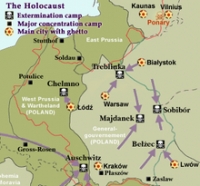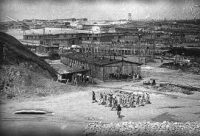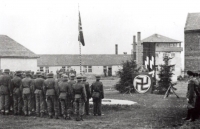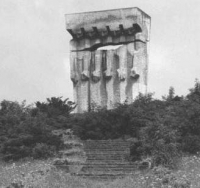Plaszow camp
In 1939 Poland had been attacked by the Nazi Germany. In autumn 1942 the Nazis started to create a concentration camp in Plaszow, on the area of two Jewish cemeteries. Plaszow Penal Camp lasted from March 1943 to 14 January 1945. During the construction process, they used grave stones to build roads and foundations of the barracks in the camp.
The Plaszow Camp was primarily meant to be a penal mandatory work camp for Jews, then also for Poles. At the beginning, its area was about 5 hectares, but engrossed to almost 80 hectares.
In the Camp, there was a specific industrial area with Madritsch clothing factory where the prisoners were making uniforms for Nazi army, many workshops (for locksmiths, carpenters, upholsterers, mechanics, electricians, furriers, tailors, shoemakers), and a printer’s. This last workshop was a special one and very important, because there were printed (usually at night) many top secret German orders and SS documents. The prisoners worked also in storehouses, where they had to select and repair valuable things like jewellery, watches etc. stolen from them by the Nazis. Other places of prisoners’ work were Oscar Schindler’s Factory, brickyard in Bonarka, Rakowice Airport and some factories in Zablocie. The prisoners were dying from diseases, starvation, slavery work, sadistic tortures and mass executions. The idea of Camp Plaszow was to destroy the Jews and Poles physically and psychically – they worked too hard and had to live in a camp, which roads and foundations were the stones of their ancestors’ graves.
Besides Oscar Shindler’s Factory, the most known place of penal work for the prisoners was quarry Liban, built on the place of Bernard Liban’s company. Daily, there were working about 400 people – mainly Poles and Ukrainians – in very hard conditions. The general number of the prisoners who were working in this camp during these 2 years is said to be about 2 thousands. In 1993 the remnants of former Liban Penal Camp was used to take some screenshots for Stephen Spielberg’s “Oscar Schindler List”. Some scenography built for this purpose is still there.
Expansion and the end of Plaszow Camp.
At the end of 1943 the Nazis started to build crematory and gas chambers, which were never finished. In 1944 the Plaszow Camp - primarily a branch of Majdanek Camp - became bootstrap and had its own branches in Mielec and Wieliczka. In Autumn that year the camp had to be closed, for the Nazis were forced flee from Polish territory. The prisoners were sent to Auschwitz-Birkenau, Stuthoff and many other concentration camps which had active gas chambers. The amount of prisoners killed in Plaszow is said to be about 80 000. Survived only few – among them 1100 Cracow Jews saved by Oscar Schindler.
Now, on the hill nearby the area of the former Plaszow Camp stands a monument made in 1964 by W. Ceckiekicz to dignify the victims of Fascism. Next to it, on the left, stands smaller one, made in 2000 to dignify the Jewish women who passed through Plaszow Camp on their way to gas chambers of Auschwitz-Birkenau. On 14 January 1945, four days before the liberation of Krakow, the last prisoners – 178 women and 2 boys - were sent to Auschwitz.

The Holocaust

Jewish women at forced labor pulling hopper cars of quarried stones

Plaszow camp

Plaszow camp ss parade

Plaszow Memorial

Plaszow Memorial




